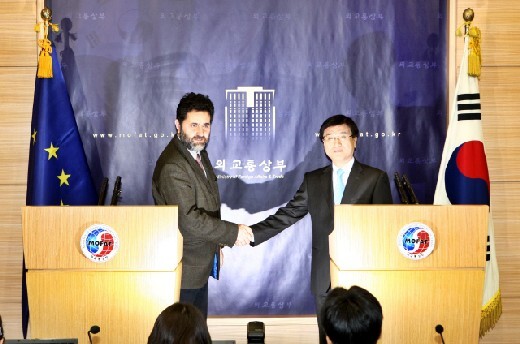hankyoreh
Links to other country sites 다른 나라 사이트 링크
[Analysis] Ratchet mechanisms are the most poisonous articles in the Korea-EU FTA

The negotiations wrapping up the free trade agreement (FTA) between South Korea and the European Union (EU) that commenced in 2007 has received scant attention. This is because not only has it been less politically symbolic in comparison to the South Korea-U.S. FTA, but because of the understanding that it contains almost no poisonous articles. However, in the draft copy of the South Korea-EU FTA that is reportedly close to conclusion obtained by the Hankyoreh, analysts say there are “bombs” here and there on the level of those in the South Korea-U.S. FTA.
To begin with, the draft includes ratchets in the product, service and investment sections. In looking at the agreement’s seven articles, South Korea and the EU have agreed not to take trade measures that will weigh down the level of the agreement, including blocking “retreats” from negative side effects that would lower the level of openness of the agreement. This very same issue had come under concentrated fire in the South Korea-US FTA.
Also controversial is the future most-favored-nation treatment conferred to the EU. In the draft, it says that if South Korea were to conclude additional FTAs with other countries granting greater openness in a sector, any benefit would automatically be conferred to the EU. Hanshin University professor Lee Hae-yeong confirms that if South Korea signs additional service or investment deals with Japan, China or another country besides the EU or the U.S., any benefits would have to be granted to the EU. This very same item had caused trouble during the South Korea-U.S. FTA negotiations.
Analysts have confirmed the most typical of the noxious articles in the South Korea-U.S. FTA, the article on investor and national lawsuits, has been left out of the South Korea-EU draft, however. Despite this, it is difficult though to say this means the problem has been resolved. Since the EU has not received the negotiating authority on matters pertaining to investor and national lawsuits from member states, the possibility still remains that individual EU nations may demand such an article be included as they conduct individual negotiations with South Korea.
The article on financial safeguards is stronger in the draft of the South Korea-EU FTA than in the South Korea-U.S. FTA. According to the draft, in the case of foreign currency market instability owing to capital movements, both sides can take safeguard measures for up to six months. The South Korea-U.S. FTA allows for safeguards to last for one year. Lawyer Song Gi-ho says that in an emergency situation like a foreign exchange crisis, strict conditions are in place for taking safeguard measures. Moreover, in regards to opening the financial market, the two sides agreed to open derivatives trading services, the source of the latest financial crisis, to the level of the South Korea-U.S. FTA. On the matter of copyrights, the two sides are agreeing to recognize copyrights for 70 years past the death of the copyright holder. This is expected to have a significant impact on South Korea‘s publishing and art sectors.
In regards to opening the beef market, the two sides are agreeing to do things based on the OIE standard, opening up for beef imports from certain EU nations that have experienced multiple outbreaks of Mad Cow Disease. An article covering permits and licenses in the pharmaceutical sector has also been included in the draft.
In comparing the negotiation of the FTA with the EU compared to the U.S., economists cite that South Korea conducted 98.4 billion dollars worth of trade with the EU last year, more than it conducted with the U.S. (84.7 billion dollars). Moreover, in terms of investment in South Korea, the EU ranks first by a considerable margin as it invested 4.33 billion dollars in South Korea in 2007, compared with only 2.34 billion dollars by the U.S.
Please direct questions or comments to [englishhani@hani.co.kr]
Editorial・opinion
![[Editorial] Intensifying US-China rivalry means Seoul must address uncertainty with Beijing sooner than later [Editorial] Intensifying US-China rivalry means Seoul must address uncertainty with Beijing sooner than later](https://flexible.img.hani.co.kr/flexible/normal/500/300/imgdb/original/2024/0517/8117159322045222.jpg) [Editorial] Intensifying US-China rivalry means Seoul must address uncertainty with Beijing sooner than later
[Editorial] Intensifying US-China rivalry means Seoul must address uncertainty with Beijing sooner than later![[Column] When ‘fairness’ means hate and violence [Column] When ‘fairness’ means hate and violence](https://flexible.img.hani.co.kr/flexible/normal/500/300/imgdb/original/2024/0516/7417158465908824.jpg) [Column] When ‘fairness’ means hate and violence
[Column] When ‘fairness’ means hate and violence- [Editorial] Yoon must stop abusing authority to shield himself from investigation
- [Column] US troop withdrawal from Korea could be the Acheson Line all over
- [Column] How to win back readers who’ve turned to YouTube for news
- [Column] Welcome to the president’s pity party
- [Editorial] Korea must respond firmly to Japan’s attempt to usurp Line
- [Editorial] Transfers of prosecutors investigating Korea’s first lady send chilling message
- [Column] Will Seoul’s ties with Moscow really recover on their own?
- [Column] Samsung’s ‘lost decade’ and Lee Jae-yong’s mismatched chopsticks
Most viewed articles
- 1Celine Song says she’s gratified global audiences have responded to the kismet of ‘inyeon’
- 2[Editorial] Transfers of prosecutors investigating Korea’s first lady send chilling message
- 3[Exclusive] Unearthed memo suggests Gwangju Uprising missing may have been cremated
- 4For new generation of Chinese artists, discontent is disobedience
- 5Xi, Putin ‘oppose acts of military intimidation’ against N. Korea by US in joint statement
- 6Highly educated high-earners at risk of being replaced by AI, BOK study says
- 7[Column] US troop withdrawal from Korea could be the Acheson Line all over
- 8USFK sprayed defoliant from 1955 to 1995, new testimony suggests
- 9Japan begins dumping irradiated Fukushima water amid outpouring of concern about vague timeline
- 10Why Kim Jong-un is scrapping the term ‘Day of the Sun’ and toning down fanfare for predecessors